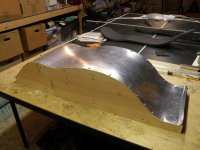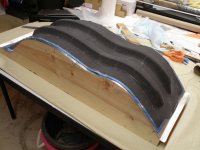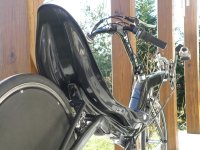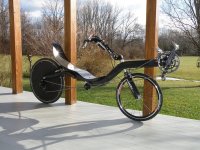Impressive stuff, what is the projected weight saving over equivalent stiffness ply?
It depends on how you apply the material, as in geometry. A 1/4" skinned panel of standard carbon will be about the same stiffness as 1/2" ply. BUT, it will possibly weigh a lot more, the same, or less. Zerokelvin's backpack challenge is practically unbeatable regarding stiffness/weight. If you were to be methodical with carbon you could maybe cut the weight of the backpack challenge in half using composites, while maintaining the same stiffness. Of course most wood cabs are way heavier than Zerokelvin's. So a less technical use of carbon would likely weigh half or less without diving into optimization. By far the easiest way to achieve high stiffness is by using skins over a thick and lightweight core. If a 1/4" sandwich is as stiff as a 1/2" wood panel, then a 1/2" sandwich will be way stiffer as it is not a linear relationship. This game can be played with wood too, however. When you start getting to absolute maximums I'm finding about a 50% weight reduction with composite, which says a lot about how great wood is. Acoustic properties are another problem though.
Last edited:
I want to know more about the manufacturing process! Is this all equipment you have home? What kind of vacuum forming is that?
Carbon waveguides? 😀 My shop setup is geared for metal. Mainly I do 3axis milling and conventional turning. My living room and workshop are essentially the same thing. If the couch is not facing a lathe then it's not home lol.
Nothing too special needed to vacuum composites. It's all about the ancillary materials like bag, breather, peel ply materials that are used to control the resin content. Composite vacuum bagging, basically.
Catching up on the comments I missed-
@TNT about safety hazards-
Yes -composites are nasty dust is the least of it. Chemical burns/fume inhalation, chemicals in eyes, all nasty. Risk vs. safety and all of those matters are up to one's specific comfort level.
@mortron about fiberglass vs. carbon-
You will get a huge boost in stiffness with carbon. Dealing with acoustic fingerprints is not yet something I can weigh in on. Hopefully soon.
@NareshBrd on pros/cons of tension-
If I want a curved panel it will de facto have to be stressed. As was mentioned, curving an otherwise flat panel will add cabinet volume which is a desirable outcome. A curved panel will also behave better with diffraction as well as internal wave propagation. This from reading as I don't personally know this to be the case from actual experience. Effects on panel stiffness- if a force/forces are acting on a panel in a static state, then pressure acting against the walls are going to encounter/be counteracted by a greater induced force. A curve is better able to distribute a force/pressure across it's surface. And finally, I'm not dogmatic about it. As was mentioned previously, "it may not be worth the effort." I have no problem dropping any number of strategies that are either too challenging to implement or perform too poorly. At this juncture this is simply an exercise in implementation and taking a concept from an idea to realization. If you don't want a curved panel, don't curve your panel. Personally I like and plan to do both. Again, I'm not worried about a structural failure of my rig.
@TNT about safety hazards-
Yes -composites are nasty dust is the least of it. Chemical burns/fume inhalation, chemicals in eyes, all nasty. Risk vs. safety and all of those matters are up to one's specific comfort level.
@mortron about fiberglass vs. carbon-
You will get a huge boost in stiffness with carbon. Dealing with acoustic fingerprints is not yet something I can weigh in on. Hopefully soon.
@NareshBrd on pros/cons of tension-
If I want a curved panel it will de facto have to be stressed. As was mentioned, curving an otherwise flat panel will add cabinet volume which is a desirable outcome. A curved panel will also behave better with diffraction as well as internal wave propagation. This from reading as I don't personally know this to be the case from actual experience. Effects on panel stiffness- if a force/forces are acting on a panel in a static state, then pressure acting against the walls are going to encounter/be counteracted by a greater induced force. A curve is better able to distribute a force/pressure across it's surface. And finally, I'm not dogmatic about it. As was mentioned previously, "it may not be worth the effort." I have no problem dropping any number of strategies that are either too challenging to implement or perform too poorly. At this juncture this is simply an exercise in implementation and taking a concept from an idea to realization. If you don't want a curved panel, don't curve your panel. Personally I like and plan to do both. Again, I'm not worried about a structural failure of my rig.
Vacuum is pretty straightforward, even for a hack like me. I'm waiting for epoxy to lay up a dirt simple balsa cored canoe paddle.
I'll be following your progress with great interests even if the tech is beyond my reach... composites are fascinating.
I'm really impressed with another relatively low tech method used in surf board construction. Comp-Sand, or composite sandwich in which a foam core is skinned with a cored composite outer later consisting of fabric/thin balsa or divinicell (sp?)/fabric vacuumed down, usually infused but I've seen some nice hand layup work as well.
I'll be following your progress with great interests even if the tech is beyond my reach... composites are fascinating.
I'm really impressed with another relatively low tech method used in surf board construction. Comp-Sand, or composite sandwich in which a foam core is skinned with a cored composite outer later consisting of fabric/thin balsa or divinicell (sp?)/fabric vacuumed down, usually infused but I've seen some nice hand layup work as well.
Hazehead - you are already quite a ways along in your fabrication path, so this advice may be completely useless...
If I wanted a curved composite panel with integral stiffening grid, my first approach (as a designer) would be to make a mold in the fully formed curved shape. Obviously that is a very complicated mold, and I understand why you did not go that route... I would not have either. It may be an optimal design, but it is horrible to fabricate.
The more practical second approach would be to lay up the skin and cure it first. Then lay up the grid liner and cure it. Then apply an adhesive between the grid and the skin, and bend them together over a form, and clamp them until the adhesive cures.
BTW that is a really awesome molding tool you cut from aluminum.
j.
If I wanted a curved composite panel with integral stiffening grid, my first approach (as a designer) would be to make a mold in the fully formed curved shape. Obviously that is a very complicated mold, and I understand why you did not go that route... I would not have either. It may be an optimal design, but it is horrible to fabricate.
The more practical second approach would be to lay up the skin and cure it first. Then lay up the grid liner and cure it. Then apply an adhesive between the grid and the skin, and bend them together over a form, and clamp them until the adhesive cures.
BTW that is a really awesome molding tool you cut from aluminum.
j.
...If I wanted a curved composite panel with integral stiffening grid, my first approach (as a designer) would be to make a mold in the fully formed curved shape. Obviously that is a very complicated mold, and I understand why you did not go that route... I would not have either. It may be an optimal design, but it is horrible to fabricate....
BTW that is a really awesome molding tool you cut from aluminum.
I agree completely with hifijim, except the part about the curved mold being hard to fabricate.
I made the very curvy carbon fiber recumbent bicycle seat shown in the pictures below, using a very simple mold made of a wood frame with an aluminum skin. I don't see why a similarly simple approach couldn't be used to make a "precurved" carbon/core/carbon composite speaker panel.
More details of my method can be found here:
Available Website
But one possible issue with making a speaker cabinet using light, stiff composite panels is that the the panels themselves may generate unwanted resonances. Stiff, light panels are used for DML (distributed mode loudspeaker) panel speakers precisely because they are very efficient at turning bending waves into sound. So you may end up creating an DML speaker whether you intend to or not.
Eric
Attachments
@Veleric
What a sexy beast! I bet you can really cruise on that thing. I once hit 47mph on a DeRosa Merak while drafting a semi. I'll never forget looking over at the next lane and seeing a kid with his face plastered against the window watching me.
In terms of a carbon cab doing undesirable things that is something of an unwritten consensus, as far as I can tell. My assumption is this is going to crop up as a problem. However, I tend to think there are enough variables and potential tweaks here and there, plus treatments, that it's worth it to me to experiment with. I'm sure if I seek out examples they will be out there. Magico's flagship is a composite carbon/Al sandwich construction. Sonus Faber has done something with carbon frames IIRC, and surely there are others. Now, is the Magico a 700K$ overrated boat anchor that resonates? I dunno. If not why not? Perhaps it weighs a ton (actually, I'm pretty sure it does). If it's carbon, does not resonate, and weighs a ton, then it should follow that carbon is not the problem. Perhaps carbon poorly implemented is where things go wrong. I would not be surprised if at a certain point wood must be used as weight gets below some certain threshold.
@hifijim
Hey, you nailed it. But I'm hedging my bets among other reasons to keep the panel flat. For one, it's easier to make a flat panel bend then to make a bent panel flat and still be usable; this way I can do either implementation. If carbon stinks at enclosure, there are a dozen other non enclosure uses it can be employed for. Tooling. As you point out, complexity goes up. But cut time goes way up, material cost goes way up and everything gets prohibitive. I like to make efficient cuts and profiling toolpaths are the opposite. Next best solution being to bond two panels into a given contour, as you mention. But that's been the plan all along, so I'm right there with you. A single uncoupled panel is so stout for my small 15-20L cab that back to back panels almost seem like overkill.
@seventenths
Right on! Consider doing some test projects just to get a feel for the unexpected. When people show composite work they don't usually show the disasters leading up to success. Especially if you use a bag; they have a bad habit of doing everything you don't want them to do. Infusion is probably the most tricky but if you have good guidance it's a nice tool.
What a sexy beast! I bet you can really cruise on that thing. I once hit 47mph on a DeRosa Merak while drafting a semi. I'll never forget looking over at the next lane and seeing a kid with his face plastered against the window watching me.
In terms of a carbon cab doing undesirable things that is something of an unwritten consensus, as far as I can tell. My assumption is this is going to crop up as a problem. However, I tend to think there are enough variables and potential tweaks here and there, plus treatments, that it's worth it to me to experiment with. I'm sure if I seek out examples they will be out there. Magico's flagship is a composite carbon/Al sandwich construction. Sonus Faber has done something with carbon frames IIRC, and surely there are others. Now, is the Magico a 700K$ overrated boat anchor that resonates? I dunno. If not why not? Perhaps it weighs a ton (actually, I'm pretty sure it does). If it's carbon, does not resonate, and weighs a ton, then it should follow that carbon is not the problem. Perhaps carbon poorly implemented is where things go wrong. I would not be surprised if at a certain point wood must be used as weight gets below some certain threshold.
@hifijim
Hey, you nailed it. But I'm hedging my bets among other reasons to keep the panel flat. For one, it's easier to make a flat panel bend then to make a bent panel flat and still be usable; this way I can do either implementation. If carbon stinks at enclosure, there are a dozen other non enclosure uses it can be employed for. Tooling. As you point out, complexity goes up. But cut time goes way up, material cost goes way up and everything gets prohibitive. I like to make efficient cuts and profiling toolpaths are the opposite. Next best solution being to bond two panels into a given contour, as you mention. But that's been the plan all along, so I'm right there with you. A single uncoupled panel is so stout for my small 15-20L cab that back to back panels almost seem like overkill.
@seventenths
Right on! Consider doing some test projects just to get a feel for the unexpected. When people show composite work they don't usually show the disasters leading up to success. Especially if you use a bag; they have a bad habit of doing everything you don't want them to do. Infusion is probably the most tricky but if you have good guidance it's a nice tool.
Cut high density foam on the milling, and then gel coat.
Bend it and use as the tool...for a few pieces bent metal or curved metal will be expensive.
You can use several layers of scrap ply joined together as the tool as well.
Bend it and use as the tool...for a few pieces bent metal or curved metal will be expensive.
You can use several layers of scrap ply joined together as the tool as well.
@ NareshBrd.
There are a dozen different ways you can go, such as your suggestion. This is just personal to me but I don't touch anything that will create dust with my gear. So pretty much metal only. Not everything is straight forward on why I choose this or that strategy. The biggest factor is what I want the workflow to be. If I run the mill it's gonna be optimized and that is not necessarily going to mean making thousands of profile passes for a curved mold. If I feel like it's worth it I'll make the exception, like for a baffle or waveguide profile. Or I could just build with wood. But that is not my workflow. What I'm doing is my workflow.
If I wanted a curved mold I'd just make the flat panel as is, curve it as designed, build it up to be a plug and pull a new curved mold off of that. It boils down to how you choose to spend your time and that is not really what I want to be doing ATM.
There are a dozen different ways you can go, such as your suggestion. This is just personal to me but I don't touch anything that will create dust with my gear. So pretty much metal only. Not everything is straight forward on why I choose this or that strategy. The biggest factor is what I want the workflow to be. If I run the mill it's gonna be optimized and that is not necessarily going to mean making thousands of profile passes for a curved mold. If I feel like it's worth it I'll make the exception, like for a baffle or waveguide profile. Or I could just build with wood. But that is not my workflow. What I'm doing is my workflow.
If I wanted a curved mold I'd just make the flat panel as is, curve it as designed, build it up to be a plug and pull a new curved mold off of that. It boils down to how you choose to spend your time and that is not really what I want to be doing ATM.
- Home
- Loudspeakers
- Multi-Way
- Carbon Composite Panel System



